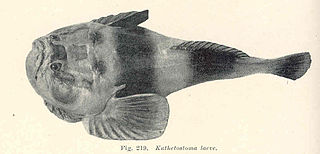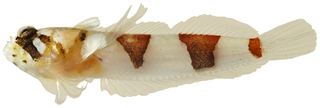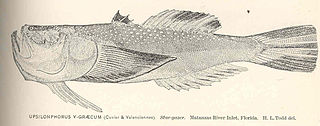Sand stargazers are blennioids; perciform marine fish of the family Dactyloscopidae. Found in temperate to tropical waters of North and South America; some may also inhabit brackish environments. The giant sand stargazer is the largest at 15 cm in length; all other species are under 10 cm.

The stargazers are a family, Uranoscopidae, of perciform fish that have eyes on top of their heads. The family includes about 51 species in eight genera, all marine and found worldwide in shallow and deep saltwaters.
Dactyloscopus is a genus of sand stargazers native to the coasts of the Americas.
Gillellus is a genus of sand stargazers, found in the eastern central Pacific Ocean and western central Atlantic Ocean.
Heteristius cinctus, the banded stargazer, is a species of sand stargazer native to the Pacific coast of the Americas from Baja California, Mexico to Ecuador where it can be found on sandy bottoms at depths of from 1 to 27 m. It can reach a maximum of 4.5 cm (1.8 in) in total length. This species is currently the only known member of its genus.
Leurochilus acon, the Smoothlip stargazer, is a species of sand stargazer native to the waters around the Caribbean islands of the Bahamas, the Virgin Islands, Antigua and Cuba where it can be found on bottoms consisting of sand, marl and rock at depths from near the surface to 8 metres (26 ft). It can reach a maximum length of 2.9 centimetres (1.1 in) SL. This species is currently the only known member of its genus.
Myxodagnus is a genus of sand stargazers, native to the Pacific and Atlantic coastal waters of the Americas.

Platygillellus is a genus of sand stargazers native to the Atlantic and Pacific coasts of the Americas.
Sindoscopus australis is a species of sand stargazer native to the Pacific coast of Chile where it can be found in shallow waters with a sandy substrate. It is currently the only known member of its genus. The generic name is a compound noun the first part of which honours Charles E. Dawson's companion in the field and collector of the type, the Chilean zoologist Gumersindo Revuelta and the second part is Latinised Greek skopos, "watcher".
Storrsia olsoni is a species of sand stargazer native to the Atlantic coast of Brazil, being endemic to Atol das Rocas and Fernando to Noronha, where it can be found in tide pools at depths of from 0 to 1 metre. It can reach a maximum length of 3 centimetres (1.2 in) SL. It is currently the only known member of its genus. The binomial name of this species honours the collector of the type, the ornithologist Storrs Olson of the National Museum of Natural History.
Dactylagnus mundus, the giant sand stargazer, is a species of sand stargazer found in the Gulf of California and along the Pacific coast of North America from Baja California to Panama as well as around the Galapagos Islands. It prefers sandy beaches down to a depth of about 5 metres (16 ft) and occasionally down to 15 metres (49 ft). It can reach a maximum length of 15 centimetres (5.9 in) SL. This species is of minor importance to local commercial fisheries.
Dactylagnus peratikos is a species of sand stargazer found along the Atlantic coast of Costa Rica and Panama. It can reach a maximum length of 6.6 centimetres (2.6 in) SL.
Dactyloscopus lacteus, the also known as the milky sand stargazer, is a species of sand stargazer endemic to the Galapagos Islands where it is the only species of Dactyloscopus known to occur there, and is a common fish in its region. It can be found in tide pools and sandy shores at depths of from 2 to 9 metres. It can grow to reach a maximum length of 5 centimetres (2.0 in) SL.
Dactyloscopus lunaticus, the moonstruck stargazer, is a species of sand stargazer native to the Pacific coast of Central America from southern Baja California to the Gulf of Panama where it can be found at depths down to 60 metres (200 ft).
Dactyloscopus poeyi, the shortchin stargazer, is a species of sand stargazer native to the coasts of the Bahamas, the Antilles and the Caribbean coast of Central and South America from Belize to Venezuela. It can be found on sandy substrates at depths of from 0 to 9 metres. It can reach a maximum length of 5.8 centimetres (2.3 in) SL. The specific name honours the Cuban ichthyologist Felipe Poey (1799-1891).
Dactyloscopus tridigitatus, the sand stargazer, is a species of sand stargazer native to the Atlantic coasts of the Americas from Florida, United States to Brazil as well as in the Caribbean Ocean and the Gulf of Mexico. It is found in sandy areas around reefs at depths of from 0 to 29 metres. It is an ambush predator, burying itself nearly completely in the sand and attacking prey animals that happen by. It can reach a maximum length of 9 centimetres (3.5 in) TL.
Gillellus arenicola, the sandy stargazer, is a species of sand stargazer native to the Pacific coast of Central America from Baja California, Mexico, to Panama where it can be found on sandy substrates at depths of from 8 to 137 metres. It can reach a maximum length of 5.5 centimetres (2.2 in) TL.

The warteye stargazer is a species of sand stargazer native to the Atlantic coast of southwestern Florida, United States, and in the Caribbean Sea from the Bahamas and the coast of Central America to Panama where it can be found in sandy areas on reefs or among rocks. It is an ambush predator, burying itself nearly completely in the sand and waiting for prey items to come along. It can reach a maximum length of 5 cm (2.0 in) TL.
Platygillellus brasiliensis, the Brazilian sand stargazer, is a species of sand stargazer native to the Atlantic coast of Brazil where it can be found at depths of from 1 to 6 metres in areas with gravel substrates in which it buries itself almost completely except the eyes and the dorsal finlet. Males of this species can reach a maximum length of 4.1 centimetres (1.6 in) SL, while females can reach a maximum length of 4.0 centimetres (1.6 in) SL.

The southern stargazer is a species of marine fish in the family Uranoscopidae and genus Astroscopus. They are native to the United States.




